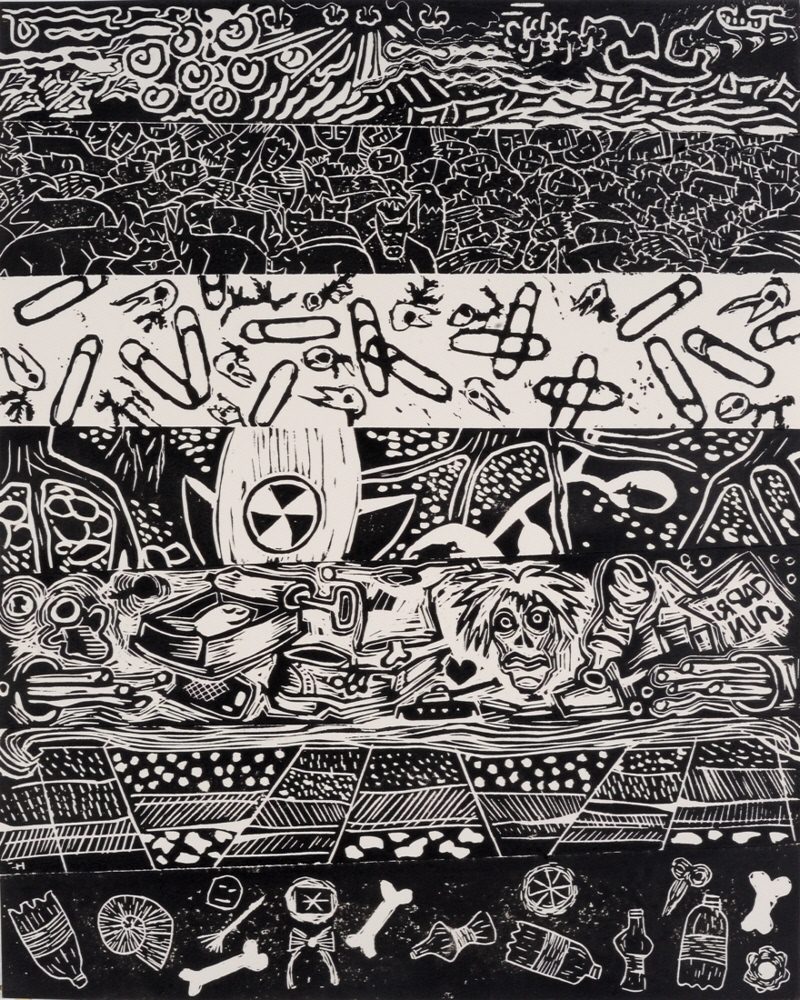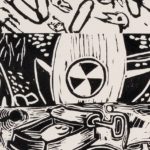![]()

Association Apog
Strates
Gravure en relief sur bois ou lino
……..
Sylvie Rimbert
Géographie du comportement
University of Strasbourg, Association Apog
A première vue, les arts et les sciences appartiennent à des domaines différents : les arts font appel à l’imaginaire; les sensations, les émotions et les sciences s’appuient sur le rationnel. Il y a longtemps que Leonardo da Vinci (1452-1519) a su les apparenter; il est connu pour son œuvre picturale ainsi que pour ses intérêts scientifiques. Qu’en est-il de nos jours de cette rencontre arts et sciences? C’est à l’occasion d’une expérimentation collective de gravure d’une planche constituée de bandes juxtaposées représentant des “strates” qu’on s’est demandé ce que peuvent en dire les Sciences de la Terre.
Un géologue y voit une étrange stratigraphie : des couches parallèles où sont fossilisés les déchets de civilisations disparues. Il faut donc passer de la géologie à l’archéologie et à l’histoire. De vieux os de la plus basse strate évoquent un ancien cimetière ou une antique bataille. Un flot de bâtonnets évoque les bacilles d’une terrible épidémie. A l’échelle historique, qui est la nôtre, ces déchets sont angoissants. Et c’est par l’angoisse que l’on passe du domaine de l’observation scientifique à celui des émotions. L’empilement de ces objets morts remplit l’époque présente et aussi l’avenir de couches étouffantes : le signe de déchets radioactifs y est inscrit pour des siècles; l’inquiétude des artistes est contemporaine: ces déchets proviennent des activités humaines… On fait alors appel à la démographie: depuis le XVIIIe siècle la population est passée d’environ 700 millions à 8 milliards d’individus qui consomment et produisent des déchets, comme jamais auparavant.
Plus nous sommes nombreux, plus il faut produire, plus il faut détruire. Une menace d’asphyxie que des artistes peuvent exprimer, alors que les politiciens ne l’osent pas? Quoi faire? Noir. C’est le choc de la couleur noire qu’ont choisi les artistes: le noir du charbon, du deuil, des nuits obscures. Frapper le spectateur, non par la beauté mais par la dureté d’un noir repoussant. Il faut de l’imagination. L’art pourrait-il en apporter? Les arts sont très liés à la mode et les modes influencent le comportement des consommateurs…
Réexaminons la planche : en haut et en bas , on voit des thèmes circulaires qui tournent ; ils moulinent des idées à venir … Les idées directrices sont le moteur de la recherche scientifique, suivi par le choix des méthodes d’analyse et celui des techniques. Chez les artistes on rencontre aussi ces trois étapes: choix d’un thème original, choix du style, choix de technique: crayon, peinture, gravure, etc. Quelle est l’idée qui a conduit au choix de strates? Une certaine inquiétude sur la pollution de notre planète… Mais aussi le moteur du plaisir de créer sa propre strate, puis celui de s’associer à une œuvre collective en empilant les trouvailles.

At first sight, arts and sciences belong to different domains: the arts appeal to the imaginary, the senses and emotions and the sciences are based on the rational. Leonardo da Vinci (1452-1519) was able to relat
e them long ago: he is known for both his pictorial work and for his scientific interests. What about today’s arts and sciences, can they or do they, meet? It was during a collective experiment involving an engraving (of a board composed of juxtaposed bands representing “strata”) that we wondered what the Earth Sciences could reveal on the matter. A geologist sees a strange stratigraphy there: parallel layers where the waste of past civilizations disappeared.
We journey through geology to archaeology and history. Old bones of the lowest stratum evoke an ancient cemetery or an ancient battle. A stream of sticks evokes the bacilli of a terrible epidemic. If examined on a historical scale, which is usual, this waste is distressing. But it is through anxiety that we then move from the field of scientific observation to that of emotions. The stacking of dead objects from the present and future eras will form stifling layers: the sign of radioactive waste is inscribed there for centuries. The concern of artists is contemporary: this waste comes from human activities.
Demography is then considered: between the eighteenth century and our 2020, the population has grown from about 700 million to 8 billion people who consume and produce waste, as never before. The more people we are, the more we must produce, the more we must destroy. A threat of asphyxiation is something that artists can express, while the politicians do not dare.
In 1972 “The Limits to Growth” was published as a report from the Club of Rome, which tried to alert humanity to the dangers of overcrowding which has been creating unsustainable pollution. Only China and Egypt reacted with dictatorial measures while Africa became a “demographic bomb”. What can we do about it? The artists chose to use the shock of the color black: the black of coal, of mourning, of dark nights. To strike the observer, not through beauty but by the hardness of a repulsive black. Wars could be considered as feedback against overcrowding. What else could be invented? Better sex education to limit, stabilize, diminish human reproduction. It’s difficult to implement. It takes imagination. Can art bring some? The arts are very fashionable and fashion trends influence consumer behavior.
Let’s re-examine the board: at the top and bottom, we see circular themes that revolve; they are churning ideas to come…The guiding ideas are the engine of scientific research, followed by the choice of methods of analysis and that of techniques. In artist’s works, we also find these three stages: choice of an original theme, choice of style, choice of technique: pencil, painting, engraving, etc. What is the idea that led to the choice of strata? Some of it stems from concern about the pollution of our planet. But there is also another engine, that of the pleasure of creating one’s own stratum, then that of associating it with a collective work by piling up the different finds.